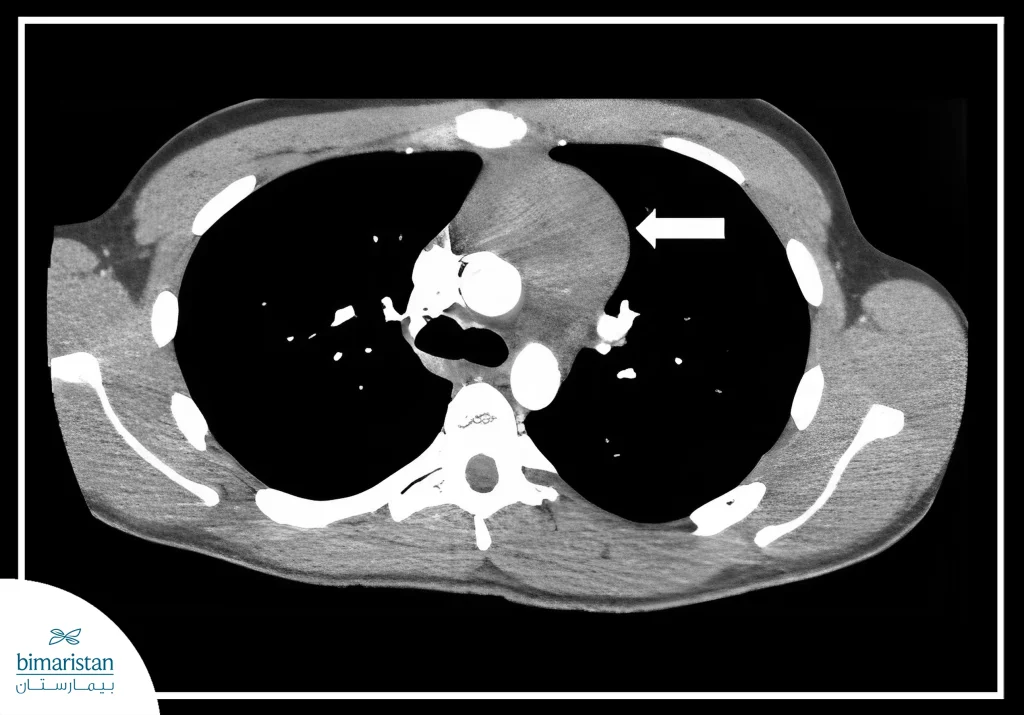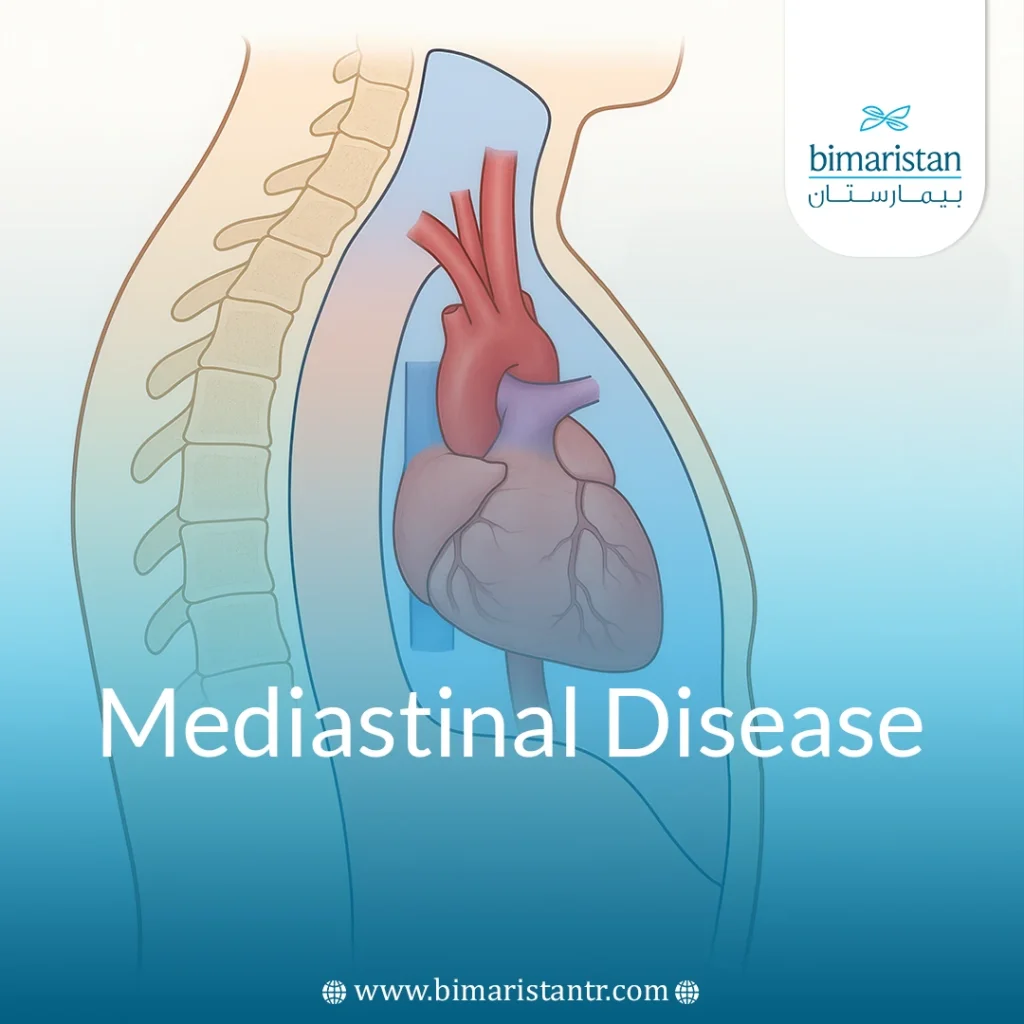The mediastinum is the space that occupies the space between the lungs in the middle of the chest, and contains vital organs such as the heart, esophagus, trachea, thymus, and lymph nodes. Because it contains many organs, various medical conditions such as cancer, benign tumors, and infections can affect the mediastinum, often without symptoms at first, and may vary in their malignancy depending on age and location. Procedures such as mediastinoscopy, chest imaging, and other techniques allow the detection of mediastinal diseases and assess the type and severity of disease in this area. In this article, we will talk about common mediastinal diseases, their causes, symptoms, diagnosis, and treatment methods.
What is the mediastinum?
The mediastinum is a cavity or space inside the chest, which is the middle part of the thoracic cavity and is located in the middle between the left and right pleural cavities (between the lungs). The importance of the mediastinum lies in the fact that it is an area bounded in front by the sternum, behind the spine, above the neck, and the diaphragm. It consists of the heart, thymus gland, some lymph nodes, parts of the trachea, esophagus, aorta, thyroid, and parathyroid, as it is divided into three sections:
- Anterior mediastinum: Located in front of the heart and contains the thymus gland, lymph nodes, and adipose tissue.
- Middle mediastinum: Located in the center of the chest and contains the heart, pericardium, ascending aorta, pulmonary arteries and veins, trachea, main bronchi, and lymph nodes.
- Posterior mediastinum: Located behind the heart and contains the esophagus, descending aorta, and other structures, including lymph nodes and nerves.
What are common mediastinal diseases?
The mediastinum has many medical conditions and diseases, most notably:
Mediastinal tumors (benign and malignant)
The type of tumor usually varies from benign to malignant depending on where it develops in the mediastinum, and common types of mediastinal tumors include: Thymomas, lymphomas, germ cell tumors, and neuromas.

Mediastinitis
A rare and serious condition that affects the mediastinum and causes inflammation and infection in it, and is caused by many reasons such as esophageal rupture, infection after surgery, or the spread of infection from neighboring areas. Inflammation is divided into two types:
- Acute mediastinitis: Occurs suddenly and is caused by a severe and serious infection of the mediastinum that causes inflammation and infection.
- Chronic mediastinitis: Occurs gradually and is associated with less severe or persistent causes.
Cysts and cystic structures
These cysts are often congenital, grow and develop slowly with age, and are often discovered accidentally during chest imaging. These cysts can cause symptoms if they compress neighboring organs, such as the trachea or esophagus. Some of the most important mediastinal cysts include bronchial, pericardial, or thymic cysts.
Mediastinal lymph node enlargement
Mediastinal lymph node enlargement may occur, which is often the result of a serious underlying condition, such as infection or inflammatory diseases such as sarcoidosis, or caused by cancerous diseases such as lymphomas or metastases.
What are the symptoms of mediastinal disease?
The mediastinum has several symptoms:
- My chest pain is behind my sternum.
- Shortness of breath.
- Chronic or dry cough.
- Difficulty swallowing (if the tumor presses on the esophagus).
- Hoarseness (due to pressure on the recurrent laryngeal nerve).
- Swelling of the face and neck (in superior vena cava syndrome).
How are mediastinal diseases diagnosed?
- Clinical examination and history: The doctor assesses the patient’s symptoms, such as cough and shortness of breath, taking into account the patient’s medical history.
- Radiographs (X-ray, CT scan, MRI): These techniques help accurately detect the presence of masses or changes in the mediastinum.
- Mediastinoscopy, endoscopy, or needle biopsy: Used to reveal the nature of the mass, whether benign or malignant, by taking a tissue sample of the mass.
- Accompanying blood tests: Tests to check for inflammation or any cancer markers to help support the diagnosis.
How are mediastinal diseases treated?
Treatment methods vary depending on the diagnosis:
- Benign tumors: Surgical treatment is often the best solution.
- Malignant tumors: The doctor resorts to surgical intervention in addition to radiation or chemotherapy.
- Inflammation: It is treated with strong antibiotics and may require surgical intervention if necessary.
- Cystic masses: These are surgically removed if they develop and show symptoms.
After a proper diagnosis is made, regular follow-up and imaging tests are an important part of the treatment plan.
Can mediastinal diseases be prevented?
Some mediastinal diseases can be prevented by:
- Preventing surgical complications that may lead to mediastinitis.
- Early detection in those with risk factors (family history, immunological tumors).
- Smoking cessation and regular chest monitoring.
In conclusion, mediastinal diseases include a wide range of conditions ranging from simple infections that can be easily treated, to malignant tumors that may require complex interventions, as early diagnosis and appropriate treatment play a crucial role in improving outcomes and minimizing complications, so it is recommended to see a doctor when any unusual chest or respiratory symptoms appear to ensure early detection of mediastinal diseases and start treatment in a timely manner.
Sources:
- Almeida, P. T., & Heller, D. (2024, April 19). Anterior mediastinal mass. In StatPearls.StatPearlsPublishing. Retrieved June 23, 2025, from
- MedlinePlus. (n.d.). Tumor mediastinal. MedlinePlus Medical Encyclopedia. Retrieved June 23, 2025, from

